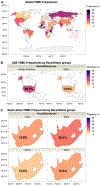Breast cancer disparities in outcomes; unmasking biological determinants associated with racial and genetic diversity
- PMID: 33950410
- PMCID: PMC9337912
- DOI: 10.1007/s10585-021-10087-x
Breast cancer disparities in outcomes; unmasking biological determinants associated with racial and genetic diversity
Abstract
Breast cancer (BC) remains a leading cause of death among women today, and mortality among African American women in the US remains 40% higher than that of their White counterparts, despite reporting a similar incidence of disease over recent years. Previous meta-analyses and studies of BC mortality highlight that tumor characteristics, rather than socio-economic factors, drive excess mortality among African American women with BC. This is further complicated by the heterogeneity of BC, where BC can more appropriately be defined as a collection of diseases rather than a single disease. Molecular phenotyping and gene expression profiling distinguish subtypes of BC, and these subtypes have distinct prognostic outcomes. Racial disparities transcend these subtype-specific outcomes, where African American women suffer higher mortality rates among all BC subtypes. The most striking differences are observed among the most aggressive molecular subtype, triple-negative BC (TNBC), where incidence and mortality are significantly higher among African American women compared to all other race/ethnicity groups. We and others have shown that this predisposition for triple-negative disease may be linked to shared west African ancestry, where the highest rates of TNBC are observed among west African nations, and these high frequencies follow into the African diaspora. Genetic and molecular characterization of breast tumors among subtypes and racial/ethnic groups have begun to identify targets with future therapeutic potential, but more work needs to be done to identify targeted treatment options for all women who suffer from BC.
Keywords: Breast cancer disparities; Breast cancer heterogeneity.
© 2021. The Author(s), under exclusive licence to Springer Nature B.V.
Figures




References
-
- Siegel RL, Miller KD, Jemal A (2020) Cancer statistics, 2020. CA Cancer J Clin 70(1):7–30 - PubMed
-
- Global Burden of Disease Cancer C, Fitzmaurice C, Akinyemiju TF, Al Lami FH, Alam T, Alizadeh-Navaei R, Allen C, Alsharif U, Alvis-Guzman N, Amini E et al. (2018) Global, regional, and national cancer incidence, mortality, years of life lost, years lived with disability, and disability-adjusted life-years for 29 cancer groups, 1990 to 2016: a systematic analysis for the global burden of disease study. JAMA Oncol 4(11):1553–1568 - PMC - PubMed
-
- Torre LA, Islami F, Siegel RL, Ward EM, Jemal A (2017) Global cancer in women: burden and trends. Cancer Epidemiol Biomarkers Prev 26(4):444–457 - PubMed
-
- DeSantis CE, Ma J, Gaudet MM, Newman LA, Miller KD, Goding Sauer A, Jemal A, Siegel RL (2019) Breast cancer statistics, 2019. CA Cancer J Clin 69(6):438–451 - PubMed
Publication types
MeSH terms
Grants and funding
LinkOut - more resources
Full Text Sources
Medical

